Marriott International: Strategic Analysis in Global Market
VerifiedAdded on 2020/01/15
|23
|8908
|216
Report
AI Summary
This report presents a comprehensive analysis of Marriott International's strategy within the global tourism and hospitality sector. It begins with an environmental and competitive analysis, utilizing the PESTLE and Porter's Five Forces models to assess external factors and competitive dynamics. A SWOT analysis identifies Marriott's core capabilities, strengths, weaknesses, opportunities, and threats. The report then explores potential strategic options, including cost leadership, differentiation, and cost focus strategies, along with online promotions and expansion plans. Challenges related to implementing the recommended strategies are also discussed. The report concludes with an overview of the company's organizational culture and drivers of change, providing recommendations for strategic improvement and innovation. The report aims to determine if Marriott's success is strategically sustainable and discusses the implementation challenges associated with the recommended strategy.
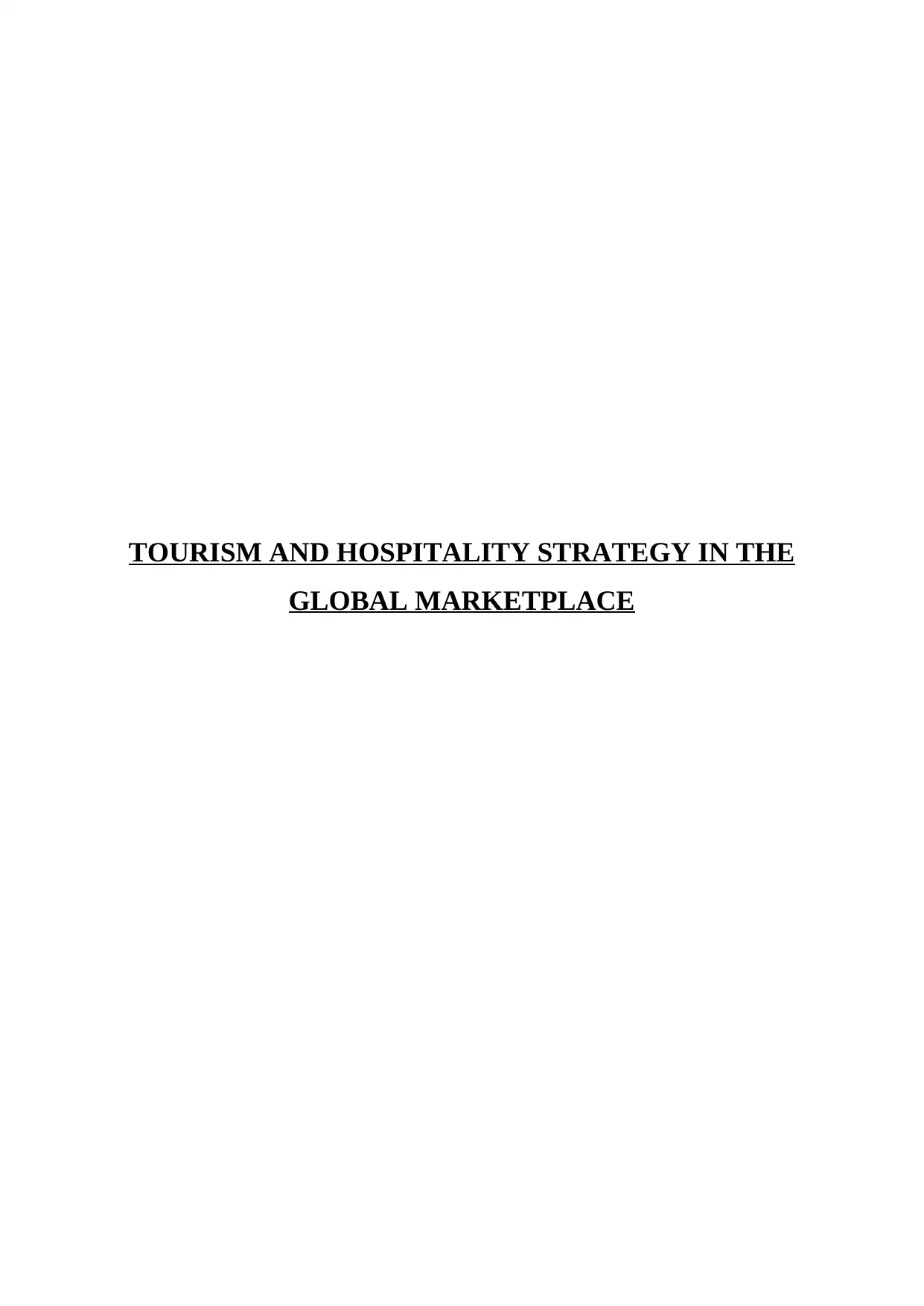
TOURISM AND HOSPITALITY STRATEGY IN THE
GLOBAL MARKETPLACE
GLOBAL MARKETPLACE
Paraphrase This Document
Need a fresh take? Get an instant paraphrase of this document with our AI Paraphraser
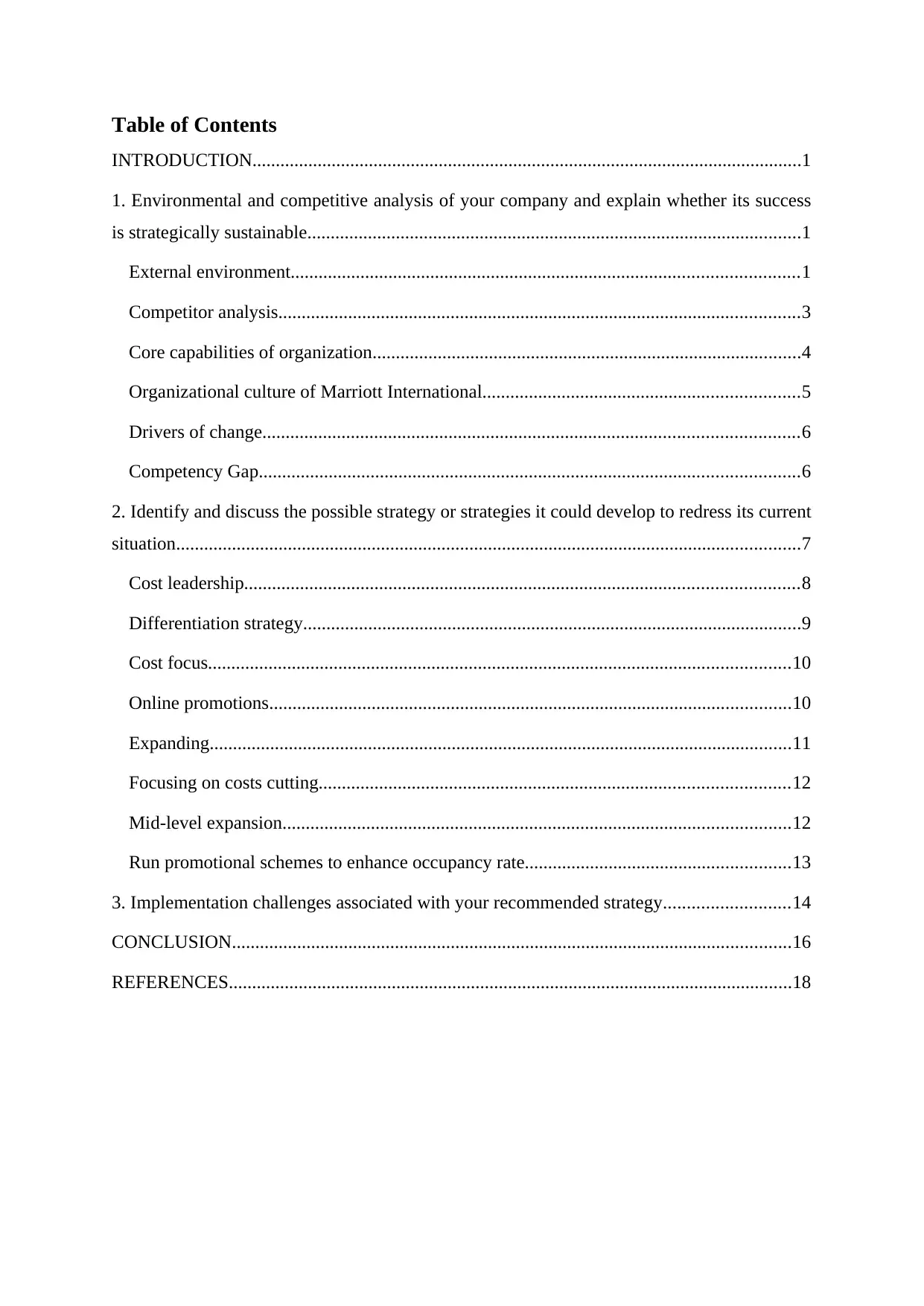
Table of Contents
INTRODUCTION......................................................................................................................1
1. Environmental and competitive analysis of your company and explain whether its success
is strategically sustainable..........................................................................................................1
External environment.............................................................................................................1
Competitor analysis................................................................................................................3
Core capabilities of organization............................................................................................4
Organizational culture of Marriott International....................................................................5
Drivers of change...................................................................................................................6
Competency Gap....................................................................................................................6
2. Identify and discuss the possible strategy or strategies it could develop to redress its current
situation......................................................................................................................................7
Cost leadership.......................................................................................................................8
Differentiation strategy...........................................................................................................9
Cost focus.............................................................................................................................10
Online promotions................................................................................................................10
Expanding.............................................................................................................................11
Focusing on costs cutting.....................................................................................................12
Mid-level expansion.............................................................................................................12
Run promotional schemes to enhance occupancy rate.........................................................13
3. Implementation challenges associated with your recommended strategy...........................14
CONCLUSION........................................................................................................................16
REFERENCES.........................................................................................................................18
INTRODUCTION......................................................................................................................1
1. Environmental and competitive analysis of your company and explain whether its success
is strategically sustainable..........................................................................................................1
External environment.............................................................................................................1
Competitor analysis................................................................................................................3
Core capabilities of organization............................................................................................4
Organizational culture of Marriott International....................................................................5
Drivers of change...................................................................................................................6
Competency Gap....................................................................................................................6
2. Identify and discuss the possible strategy or strategies it could develop to redress its current
situation......................................................................................................................................7
Cost leadership.......................................................................................................................8
Differentiation strategy...........................................................................................................9
Cost focus.............................................................................................................................10
Online promotions................................................................................................................10
Expanding.............................................................................................................................11
Focusing on costs cutting.....................................................................................................12
Mid-level expansion.............................................................................................................12
Run promotional schemes to enhance occupancy rate.........................................................13
3. Implementation challenges associated with your recommended strategy...........................14
CONCLUSION........................................................................................................................16
REFERENCES.........................................................................................................................18
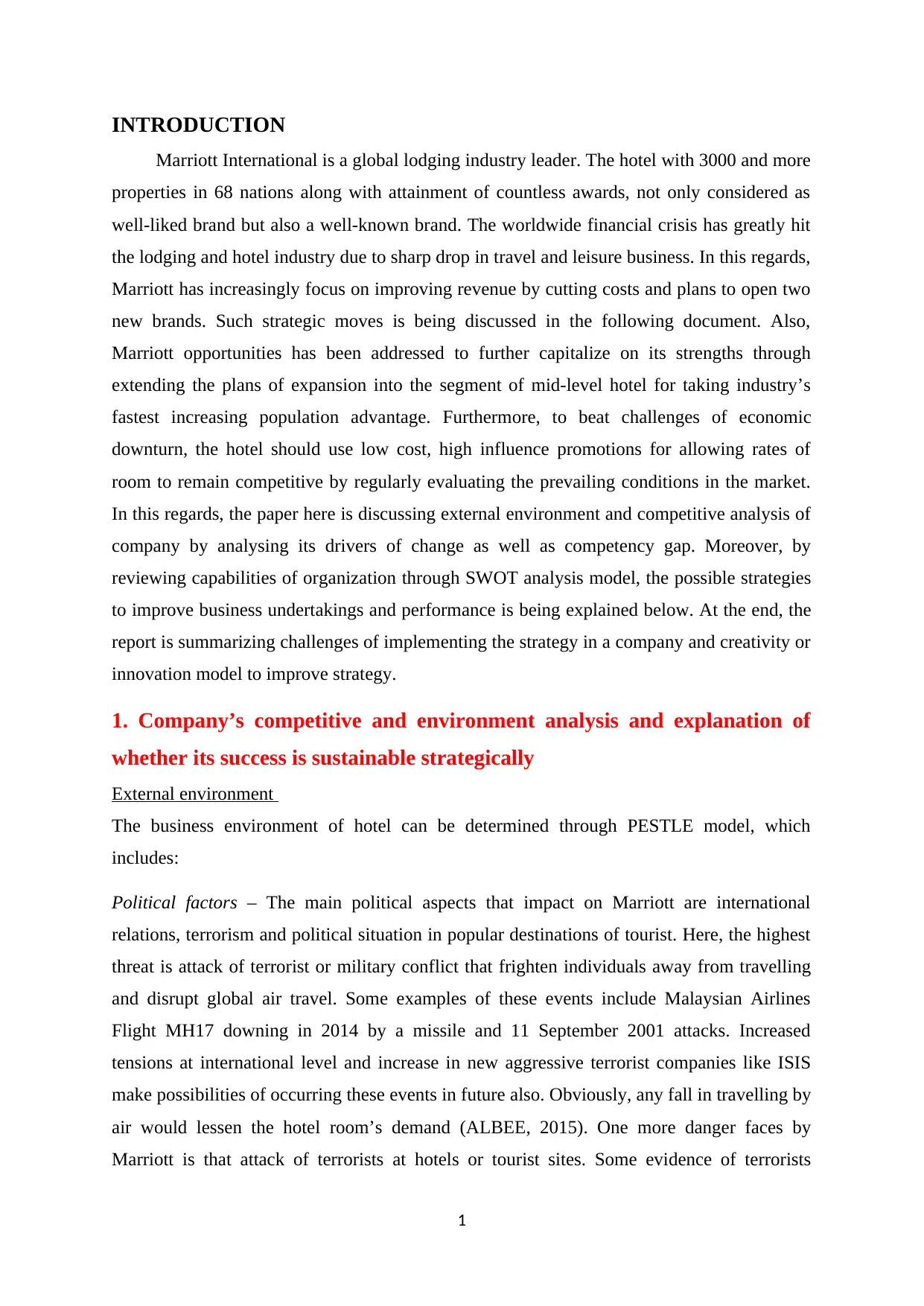
INTRODUCTION
Marriott International is a global lodging industry leader. The hotel with 3000 and more
properties in 68 nations along with attainment of countless awards, not only considered as
well-liked brand but also a well-known brand. The worldwide financial crisis has greatly hit
the lodging and hotel industry due to sharp drop in travel and leisure business. In this regards,
Marriott has increasingly focus on improving revenue by cutting costs and plans to open two
new brands. Such strategic moves is being discussed in the following document. Also,
Marriott opportunities has been addressed to further capitalize on its strengths through
extending the plans of expansion into the segment of mid-level hotel for taking industry’s
fastest increasing population advantage. Furthermore, to beat challenges of economic
downturn, the hotel should use low cost, high influence promotions for allowing rates of
room to remain competitive by regularly evaluating the prevailing conditions in the market.
In this regards, the paper here is discussing external environment and competitive analysis of
company by analysing its drivers of change as well as competency gap. Moreover, by
reviewing capabilities of organization through SWOT analysis model, the possible strategies
to improve business undertakings and performance is being explained below. At the end, the
report is summarizing challenges of implementing the strategy in a company and creativity or
innovation model to improve strategy.
1. Company’s competitive and environment analysis and explanation of
whether its success is sustainable strategically
External environment
The business environment of hotel can be determined through PESTLE model, which
includes:
Political factors – The main political aspects that impact on Marriott are international
relations, terrorism and political situation in popular destinations of tourist. Here, the highest
threat is attack of terrorist or military conflict that frighten individuals away from travelling
and disrupt global air travel. Some examples of these events include Malaysian Airlines
Flight MH17 downing in 2014 by a missile and 11 September 2001 attacks. Increased
tensions at international level and increase in new aggressive terrorist companies like ISIS
make possibilities of occurring these events in future also. Obviously, any fall in travelling by
air would lessen the hotel room’s demand (ALBEE, 2015). One more danger faces by
Marriott is that attack of terrorists at hotels or tourist sites. Some evidence of terrorists
1
Marriott International is a global lodging industry leader. The hotel with 3000 and more
properties in 68 nations along with attainment of countless awards, not only considered as
well-liked brand but also a well-known brand. The worldwide financial crisis has greatly hit
the lodging and hotel industry due to sharp drop in travel and leisure business. In this regards,
Marriott has increasingly focus on improving revenue by cutting costs and plans to open two
new brands. Such strategic moves is being discussed in the following document. Also,
Marriott opportunities has been addressed to further capitalize on its strengths through
extending the plans of expansion into the segment of mid-level hotel for taking industry’s
fastest increasing population advantage. Furthermore, to beat challenges of economic
downturn, the hotel should use low cost, high influence promotions for allowing rates of
room to remain competitive by regularly evaluating the prevailing conditions in the market.
In this regards, the paper here is discussing external environment and competitive analysis of
company by analysing its drivers of change as well as competency gap. Moreover, by
reviewing capabilities of organization through SWOT analysis model, the possible strategies
to improve business undertakings and performance is being explained below. At the end, the
report is summarizing challenges of implementing the strategy in a company and creativity or
innovation model to improve strategy.
1. Company’s competitive and environment analysis and explanation of
whether its success is sustainable strategically
External environment
The business environment of hotel can be determined through PESTLE model, which
includes:
Political factors – The main political aspects that impact on Marriott are international
relations, terrorism and political situation in popular destinations of tourist. Here, the highest
threat is attack of terrorist or military conflict that frighten individuals away from travelling
and disrupt global air travel. Some examples of these events include Malaysian Airlines
Flight MH17 downing in 2014 by a missile and 11 September 2001 attacks. Increased
tensions at international level and increase in new aggressive terrorist companies like ISIS
make possibilities of occurring these events in future also. Obviously, any fall in travelling by
air would lessen the hotel room’s demand (ALBEE, 2015). One more danger faces by
Marriott is that attack of terrorists at hotels or tourist sites. Some evidence of terrorists
1
⊘ This is a preview!⊘
Do you want full access?
Subscribe today to unlock all pages.

Trusted by 1+ million students worldwide
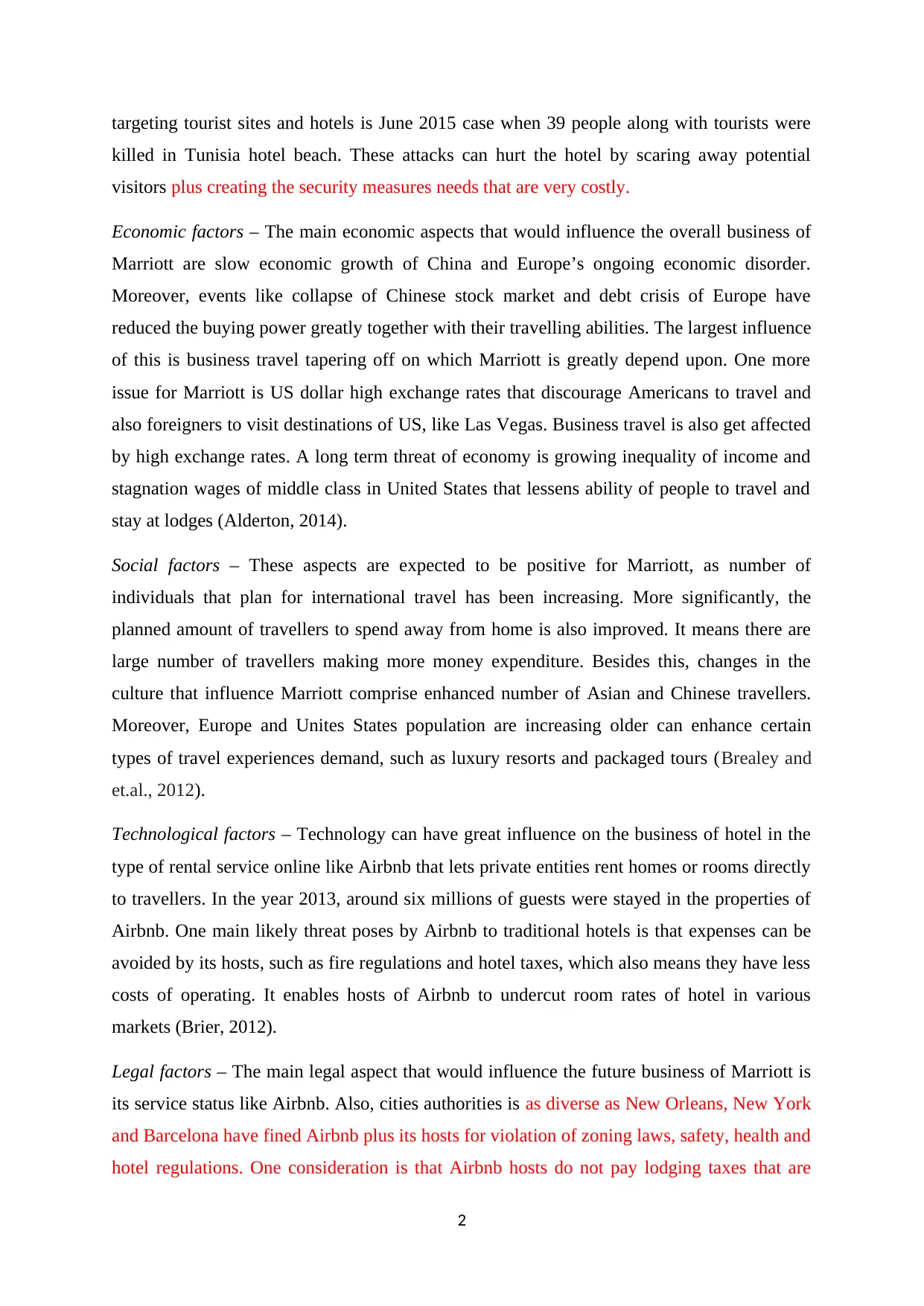
targeting tourist sites and hotels is June 2015 case when 39 people along with tourists were
killed in Tunisia hotel beach. These attacks can hurt the hotel by scaring away potential
visitors plus creating the security measures needs that are very costly.
Economic factors – The main economic aspects that would influence the overall business of
Marriott are slow economic growth of China and Europe’s ongoing economic disorder.
Moreover, events like collapse of Chinese stock market and debt crisis of Europe have
reduced the buying power greatly together with their travelling abilities. The largest influence
of this is business travel tapering off on which Marriott is greatly depend upon. One more
issue for Marriott is US dollar high exchange rates that discourage Americans to travel and
also foreigners to visit destinations of US, like Las Vegas. Business travel is also get affected
by high exchange rates. A long term threat of economy is growing inequality of income and
stagnation wages of middle class in United States that lessens ability of people to travel and
stay at lodges (Alderton, 2014).
Social factors – These aspects are expected to be positive for Marriott, as number of
individuals that plan for international travel has been increasing. More significantly, the
planned amount of travellers to spend away from home is also improved. It means there are
large number of travellers making more money expenditure. Besides this, changes in the
culture that influence Marriott comprise enhanced number of Asian and Chinese travellers.
Moreover, Europe and Unites States population are increasing older can enhance certain
types of travel experiences demand, such as luxury resorts and packaged tours (Brealey and
et.al., 2012).
Technological factors – Technology can have great influence on the business of hotel in the
type of rental service online like Airbnb that lets private entities rent homes or rooms directly
to travellers. In the year 2013, around six millions of guests were stayed in the properties of
Airbnb. One main likely threat poses by Airbnb to traditional hotels is that expenses can be
avoided by its hosts, such as fire regulations and hotel taxes, which also means they have less
costs of operating. It enables hosts of Airbnb to undercut room rates of hotel in various
markets (Brier, 2012).
Legal factors – The main legal aspect that would influence the future business of Marriott is
its service status like Airbnb. Also, cities authorities is as diverse as New Orleans, New York
and Barcelona have fined Airbnb plus its hosts for violation of zoning laws, safety, health and
hotel regulations. One consideration is that Airbnb hosts do not pay lodging taxes that are
2
killed in Tunisia hotel beach. These attacks can hurt the hotel by scaring away potential
visitors plus creating the security measures needs that are very costly.
Economic factors – The main economic aspects that would influence the overall business of
Marriott are slow economic growth of China and Europe’s ongoing economic disorder.
Moreover, events like collapse of Chinese stock market and debt crisis of Europe have
reduced the buying power greatly together with their travelling abilities. The largest influence
of this is business travel tapering off on which Marriott is greatly depend upon. One more
issue for Marriott is US dollar high exchange rates that discourage Americans to travel and
also foreigners to visit destinations of US, like Las Vegas. Business travel is also get affected
by high exchange rates. A long term threat of economy is growing inequality of income and
stagnation wages of middle class in United States that lessens ability of people to travel and
stay at lodges (Alderton, 2014).
Social factors – These aspects are expected to be positive for Marriott, as number of
individuals that plan for international travel has been increasing. More significantly, the
planned amount of travellers to spend away from home is also improved. It means there are
large number of travellers making more money expenditure. Besides this, changes in the
culture that influence Marriott comprise enhanced number of Asian and Chinese travellers.
Moreover, Europe and Unites States population are increasing older can enhance certain
types of travel experiences demand, such as luxury resorts and packaged tours (Brealey and
et.al., 2012).
Technological factors – Technology can have great influence on the business of hotel in the
type of rental service online like Airbnb that lets private entities rent homes or rooms directly
to travellers. In the year 2013, around six millions of guests were stayed in the properties of
Airbnb. One main likely threat poses by Airbnb to traditional hotels is that expenses can be
avoided by its hosts, such as fire regulations and hotel taxes, which also means they have less
costs of operating. It enables hosts of Airbnb to undercut room rates of hotel in various
markets (Brier, 2012).
Legal factors – The main legal aspect that would influence the future business of Marriott is
its service status like Airbnb. Also, cities authorities is as diverse as New Orleans, New York
and Barcelona have fined Airbnb plus its hosts for violation of zoning laws, safety, health and
hotel regulations. One consideration is that Airbnb hosts do not pay lodging taxes that are
2
Paraphrase This Document
Need a fresh take? Get an instant paraphrase of this document with our AI Paraphraser
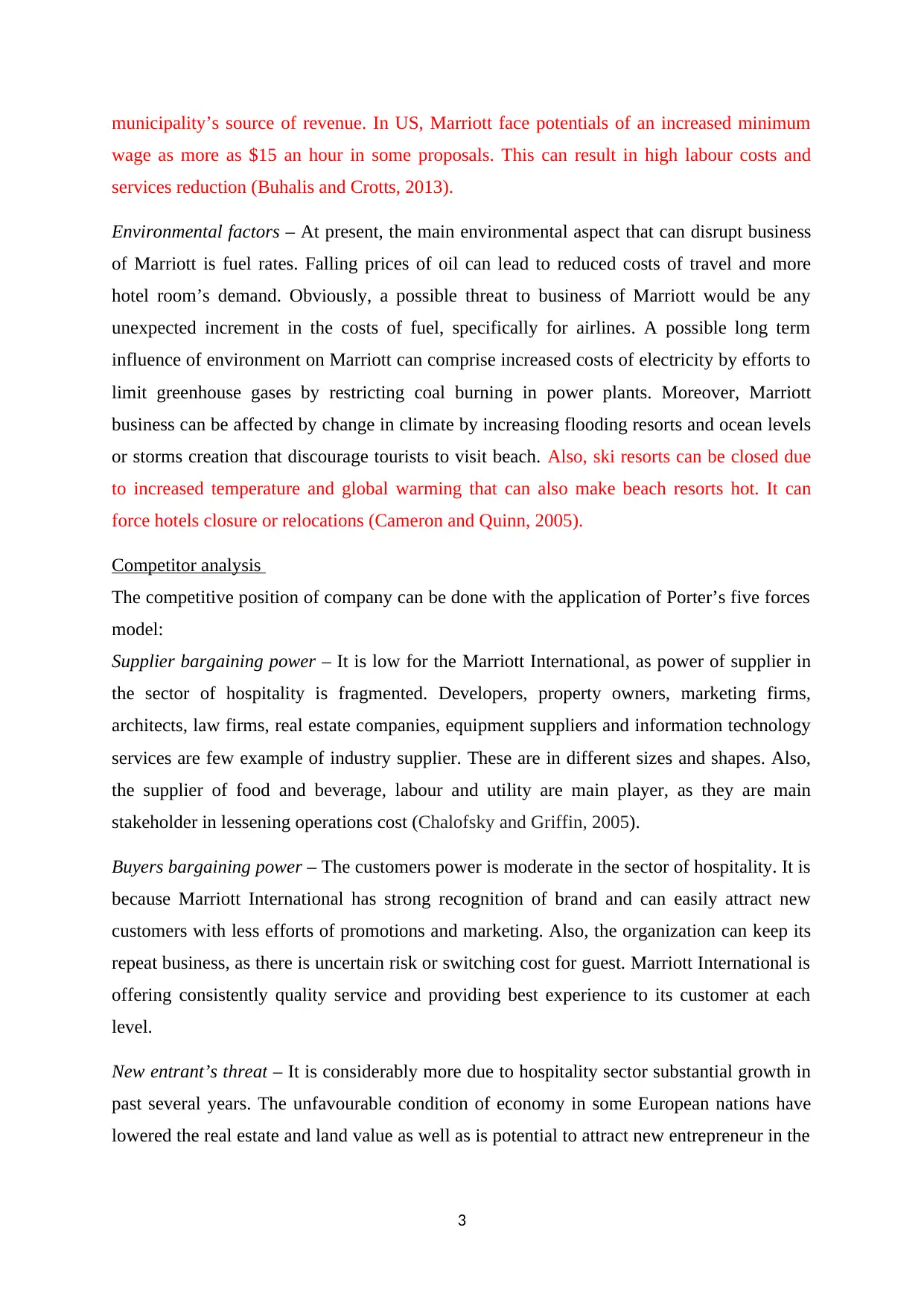
municipality’s source of revenue. In US, Marriott face potentials of an increased minimum
wage as more as $15 an hour in some proposals. This can result in high labour costs and
services reduction (Buhalis and Crotts, 2013).
Environmental factors – At present, the main environmental aspect that can disrupt business
of Marriott is fuel rates. Falling prices of oil can lead to reduced costs of travel and more
hotel room’s demand. Obviously, a possible threat to business of Marriott would be any
unexpected increment in the costs of fuel, specifically for airlines. A possible long term
influence of environment on Marriott can comprise increased costs of electricity by efforts to
limit greenhouse gases by restricting coal burning in power plants. Moreover, Marriott
business can be affected by change in climate by increasing flooding resorts and ocean levels
or storms creation that discourage tourists to visit beach. Also, ski resorts can be closed due
to increased temperature and global warming that can also make beach resorts hot. It can
force hotels closure or relocations (Cameron and Quinn, 2005).
Competitor analysis
The competitive position of company can be done with the application of Porter’s five forces
model:
Supplier bargaining power – It is low for the Marriott International, as power of supplier in
the sector of hospitality is fragmented. Developers, property owners, marketing firms,
architects, law firms, real estate companies, equipment suppliers and information technology
services are few example of industry supplier. These are in different sizes and shapes. Also,
the supplier of food and beverage, labour and utility are main player, as they are main
stakeholder in lessening operations cost (Chalofsky and Griffin, 2005).
Buyers bargaining power – The customers power is moderate in the sector of hospitality. It is
because Marriott International has strong recognition of brand and can easily attract new
customers with less efforts of promotions and marketing. Also, the organization can keep its
repeat business, as there is uncertain risk or switching cost for guest. Marriott International is
offering consistently quality service and providing best experience to its customer at each
level.
New entrant’s threat – It is considerably more due to hospitality sector substantial growth in
past several years. The unfavourable condition of economy in some European nations have
lowered the real estate and land value as well as is potential to attract new entrepreneur in the
3
wage as more as $15 an hour in some proposals. This can result in high labour costs and
services reduction (Buhalis and Crotts, 2013).
Environmental factors – At present, the main environmental aspect that can disrupt business
of Marriott is fuel rates. Falling prices of oil can lead to reduced costs of travel and more
hotel room’s demand. Obviously, a possible threat to business of Marriott would be any
unexpected increment in the costs of fuel, specifically for airlines. A possible long term
influence of environment on Marriott can comprise increased costs of electricity by efforts to
limit greenhouse gases by restricting coal burning in power plants. Moreover, Marriott
business can be affected by change in climate by increasing flooding resorts and ocean levels
or storms creation that discourage tourists to visit beach. Also, ski resorts can be closed due
to increased temperature and global warming that can also make beach resorts hot. It can
force hotels closure or relocations (Cameron and Quinn, 2005).
Competitor analysis
The competitive position of company can be done with the application of Porter’s five forces
model:
Supplier bargaining power – It is low for the Marriott International, as power of supplier in
the sector of hospitality is fragmented. Developers, property owners, marketing firms,
architects, law firms, real estate companies, equipment suppliers and information technology
services are few example of industry supplier. These are in different sizes and shapes. Also,
the supplier of food and beverage, labour and utility are main player, as they are main
stakeholder in lessening operations cost (Chalofsky and Griffin, 2005).
Buyers bargaining power – The customers power is moderate in the sector of hospitality. It is
because Marriott International has strong recognition of brand and can easily attract new
customers with less efforts of promotions and marketing. Also, the organization can keep its
repeat business, as there is uncertain risk or switching cost for guest. Marriott International is
offering consistently quality service and providing best experience to its customer at each
level.
New entrant’s threat – It is considerably more due to hospitality sector substantial growth in
past several years. The unfavourable condition of economy in some European nations have
lowered the real estate and land value as well as is potential to attract new entrepreneur in the
3
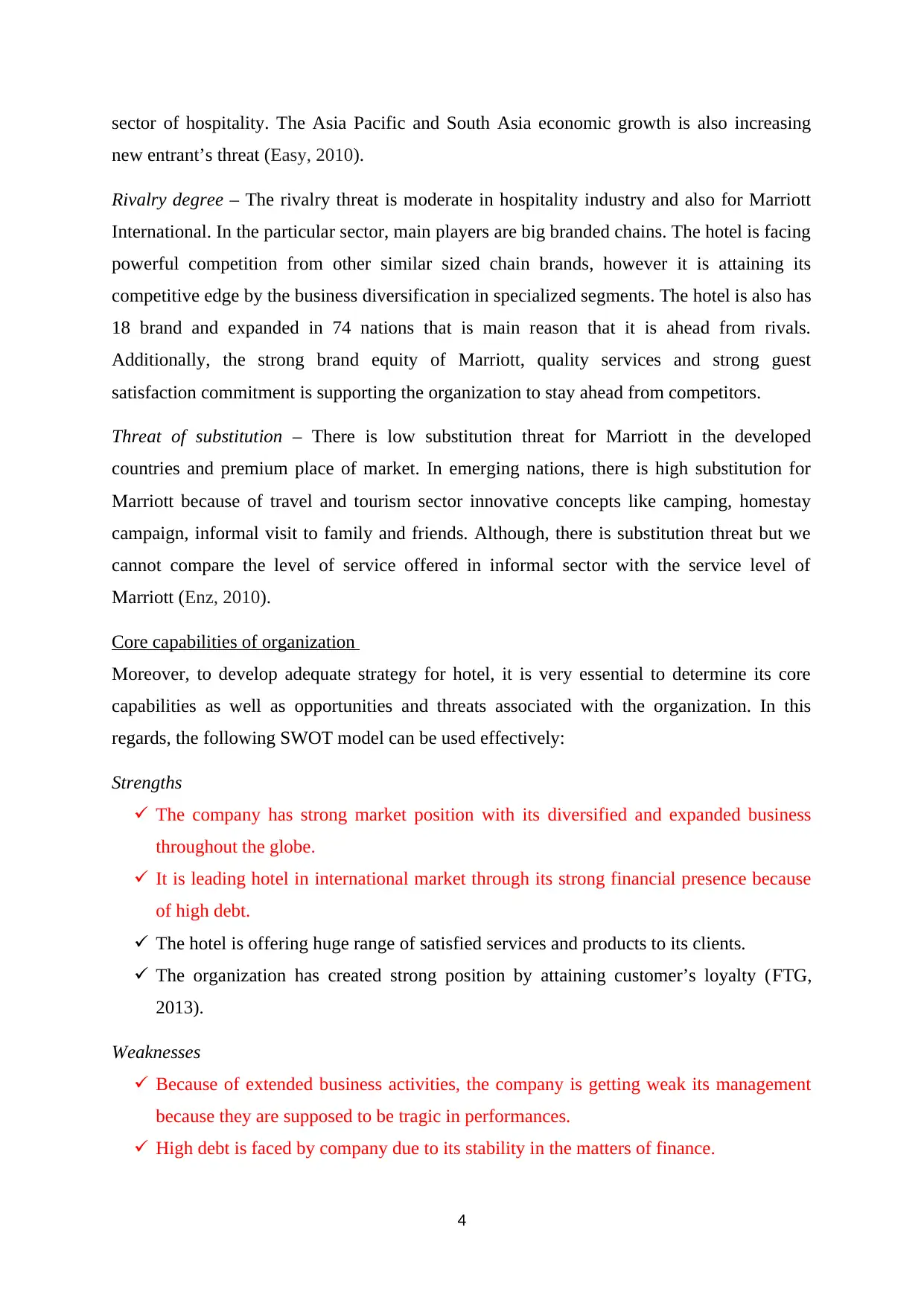
sector of hospitality. The Asia Pacific and South Asia economic growth is also increasing
new entrant’s threat (Easy, 2010).
Rivalry degree – The rivalry threat is moderate in hospitality industry and also for Marriott
International. In the particular sector, main players are big branded chains. The hotel is facing
powerful competition from other similar sized chain brands, however it is attaining its
competitive edge by the business diversification in specialized segments. The hotel is also has
18 brand and expanded in 74 nations that is main reason that it is ahead from rivals.
Additionally, the strong brand equity of Marriott, quality services and strong guest
satisfaction commitment is supporting the organization to stay ahead from competitors.
Threat of substitution – There is low substitution threat for Marriott in the developed
countries and premium place of market. In emerging nations, there is high substitution for
Marriott because of travel and tourism sector innovative concepts like camping, homestay
campaign, informal visit to family and friends. Although, there is substitution threat but we
cannot compare the level of service offered in informal sector with the service level of
Marriott (Enz, 2010).
Core capabilities of organization
Moreover, to develop adequate strategy for hotel, it is very essential to determine its core
capabilities as well as opportunities and threats associated with the organization. In this
regards, the following SWOT model can be used effectively:
Strengths
The company has strong market position with its diversified and expanded business
throughout the globe.
It is leading hotel in international market through its strong financial presence because
of high debt.
The hotel is offering huge range of satisfied services and products to its clients.
The organization has created strong position by attaining customer’s loyalty (FTG,
2013).
Weaknesses
Because of extended business activities, the company is getting weak its management
because they are supposed to be tragic in performances.
High debt is faced by company due to its stability in the matters of finance.
4
new entrant’s threat (Easy, 2010).
Rivalry degree – The rivalry threat is moderate in hospitality industry and also for Marriott
International. In the particular sector, main players are big branded chains. The hotel is facing
powerful competition from other similar sized chain brands, however it is attaining its
competitive edge by the business diversification in specialized segments. The hotel is also has
18 brand and expanded in 74 nations that is main reason that it is ahead from rivals.
Additionally, the strong brand equity of Marriott, quality services and strong guest
satisfaction commitment is supporting the organization to stay ahead from competitors.
Threat of substitution – There is low substitution threat for Marriott in the developed
countries and premium place of market. In emerging nations, there is high substitution for
Marriott because of travel and tourism sector innovative concepts like camping, homestay
campaign, informal visit to family and friends. Although, there is substitution threat but we
cannot compare the level of service offered in informal sector with the service level of
Marriott (Enz, 2010).
Core capabilities of organization
Moreover, to develop adequate strategy for hotel, it is very essential to determine its core
capabilities as well as opportunities and threats associated with the organization. In this
regards, the following SWOT model can be used effectively:
Strengths
The company has strong market position with its diversified and expanded business
throughout the globe.
It is leading hotel in international market through its strong financial presence because
of high debt.
The hotel is offering huge range of satisfied services and products to its clients.
The organization has created strong position by attaining customer’s loyalty (FTG,
2013).
Weaknesses
Because of extended business activities, the company is getting weak its management
because they are supposed to be tragic in performances.
High debt is faced by company due to its stability in the matters of finance.
4
⊘ This is a preview!⊘
Do you want full access?
Subscribe today to unlock all pages.

Trusted by 1+ million students worldwide
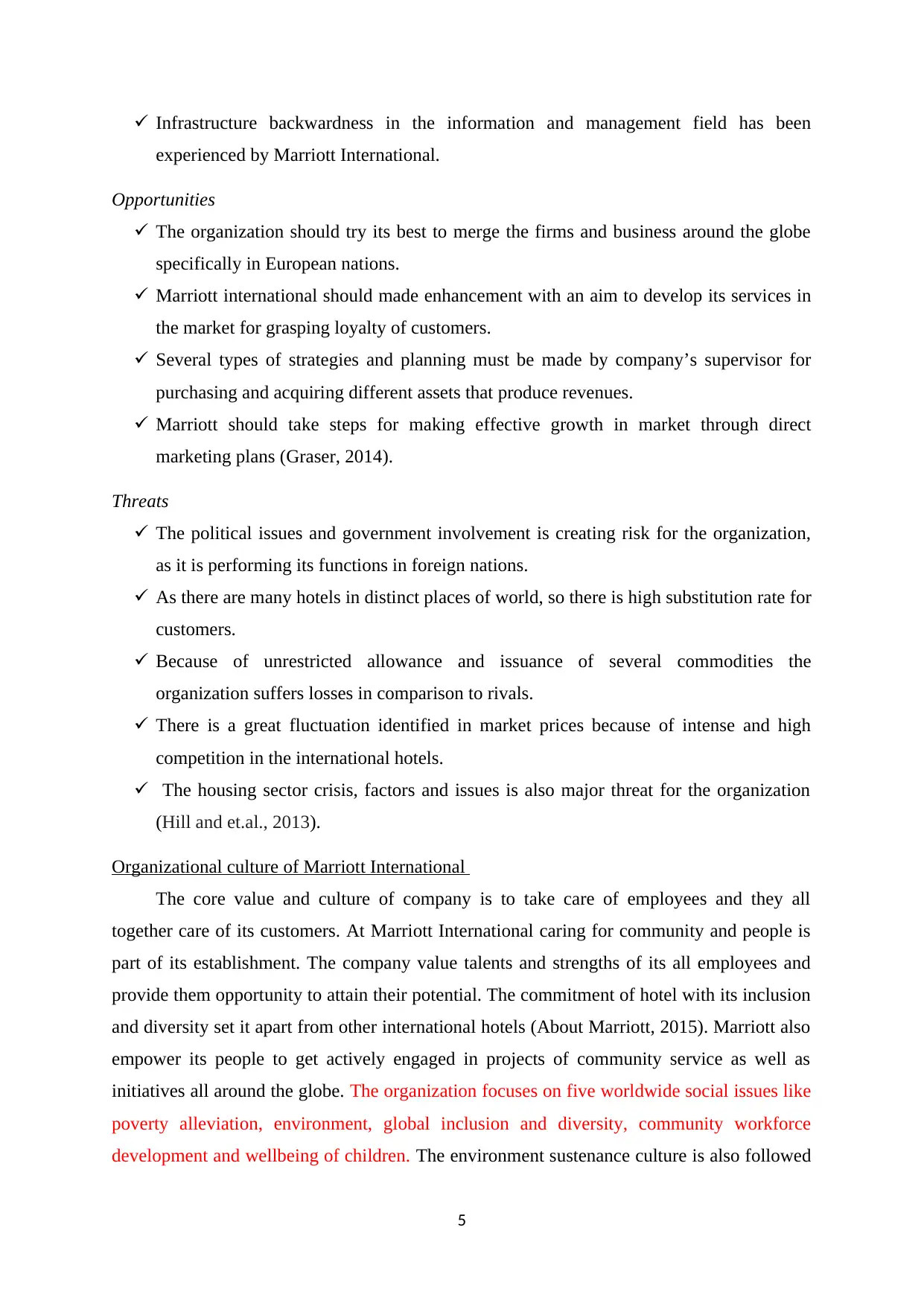
Infrastructure backwardness in the information and management field has been
experienced by Marriott International.
Opportunities
The organization should try its best to merge the firms and business around the globe
specifically in European nations.
Marriott international should made enhancement with an aim to develop its services in
the market for grasping loyalty of customers.
Several types of strategies and planning must be made by company’s supervisor for
purchasing and acquiring different assets that produce revenues.
Marriott should take steps for making effective growth in market through direct
marketing plans (Graser, 2014).
Threats
The political issues and government involvement is creating risk for the organization,
as it is performing its functions in foreign nations.
As there are many hotels in distinct places of world, so there is high substitution rate for
customers.
Because of unrestricted allowance and issuance of several commodities the
organization suffers losses in comparison to rivals.
There is a great fluctuation identified in market prices because of intense and high
competition in the international hotels.
The housing sector crisis, factors and issues is also major threat for the organization
(Hill and et.al., 2013).
Organizational culture of Marriott International
The core value and culture of company is to take care of employees and they all
together care of its customers. At Marriott International caring for community and people is
part of its establishment. The company value talents and strengths of its all employees and
provide them opportunity to attain their potential. The commitment of hotel with its inclusion
and diversity set it apart from other international hotels (About Marriott, 2015). Marriott also
empower its people to get actively engaged in projects of community service as well as
initiatives all around the globe. The organization focuses on five worldwide social issues like
poverty alleviation, environment, global inclusion and diversity, community workforce
development and wellbeing of children. The environment sustenance culture is also followed
5
experienced by Marriott International.
Opportunities
The organization should try its best to merge the firms and business around the globe
specifically in European nations.
Marriott international should made enhancement with an aim to develop its services in
the market for grasping loyalty of customers.
Several types of strategies and planning must be made by company’s supervisor for
purchasing and acquiring different assets that produce revenues.
Marriott should take steps for making effective growth in market through direct
marketing plans (Graser, 2014).
Threats
The political issues and government involvement is creating risk for the organization,
as it is performing its functions in foreign nations.
As there are many hotels in distinct places of world, so there is high substitution rate for
customers.
Because of unrestricted allowance and issuance of several commodities the
organization suffers losses in comparison to rivals.
There is a great fluctuation identified in market prices because of intense and high
competition in the international hotels.
The housing sector crisis, factors and issues is also major threat for the organization
(Hill and et.al., 2013).
Organizational culture of Marriott International
The core value and culture of company is to take care of employees and they all
together care of its customers. At Marriott International caring for community and people is
part of its establishment. The company value talents and strengths of its all employees and
provide them opportunity to attain their potential. The commitment of hotel with its inclusion
and diversity set it apart from other international hotels (About Marriott, 2015). Marriott also
empower its people to get actively engaged in projects of community service as well as
initiatives all around the globe. The organization focuses on five worldwide social issues like
poverty alleviation, environment, global inclusion and diversity, community workforce
development and wellbeing of children. The environment sustenance culture is also followed
5
Paraphrase This Document
Need a fresh take? Get an instant paraphrase of this document with our AI Paraphraser
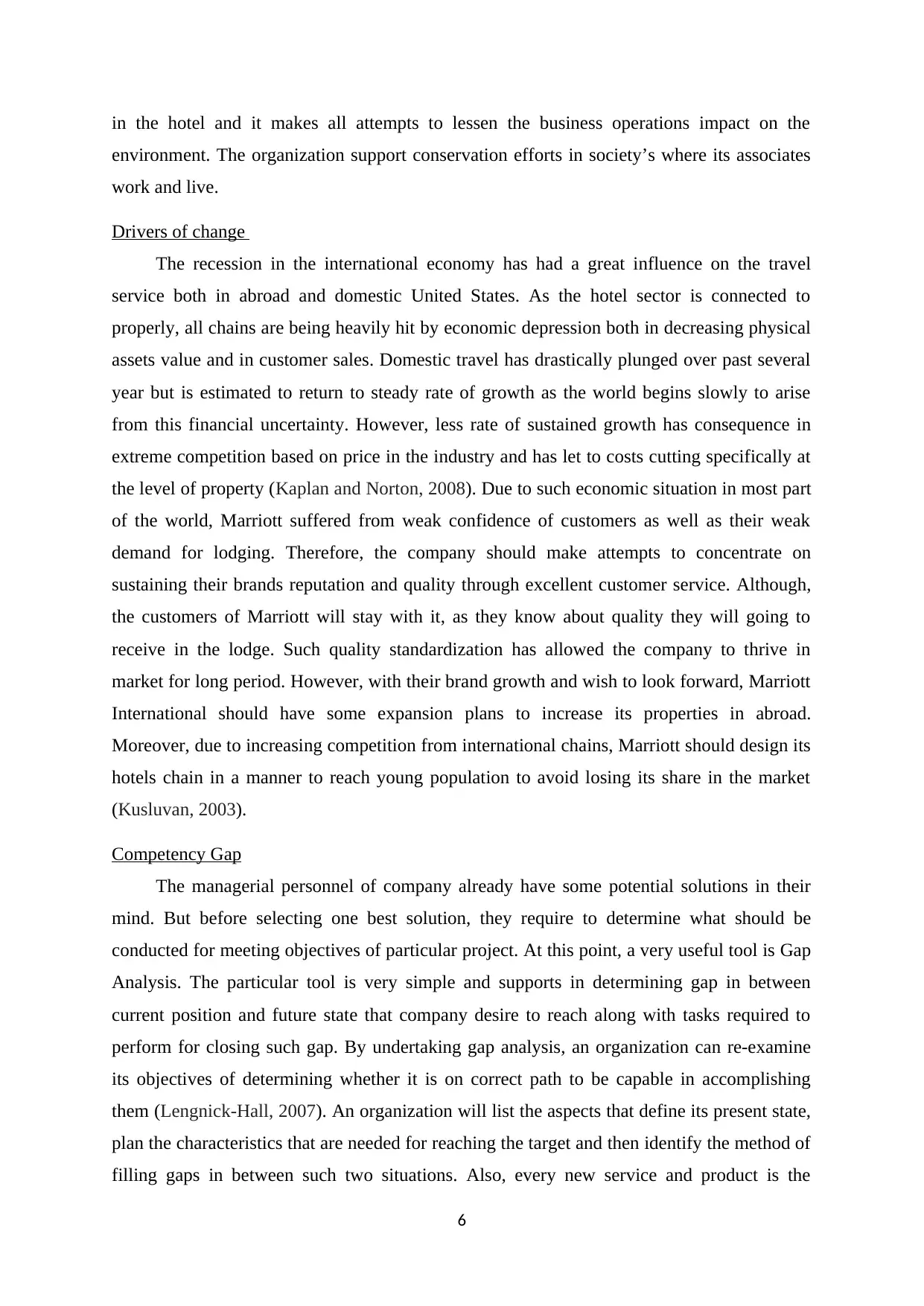
in the hotel and it makes all attempts to lessen the business operations impact on the
environment. The organization support conservation efforts in society’s where its associates
work and live.
Drivers of change
The recession in the international economy has had a great influence on the travel
service both in abroad and domestic United States. As the hotel sector is connected to
properly, all chains are being heavily hit by economic depression both in decreasing physical
assets value and in customer sales. Domestic travel has drastically plunged over past several
year but is estimated to return to steady rate of growth as the world begins slowly to arise
from this financial uncertainty. However, less rate of sustained growth has consequence in
extreme competition based on price in the industry and has let to costs cutting specifically at
the level of property (Kaplan and Norton, 2008). Due to such economic situation in most part
of the world, Marriott suffered from weak confidence of customers as well as their weak
demand for lodging. Therefore, the company should make attempts to concentrate on
sustaining their brands reputation and quality through excellent customer service. Although,
the customers of Marriott will stay with it, as they know about quality they will going to
receive in the lodge. Such quality standardization has allowed the company to thrive in
market for long period. However, with their brand growth and wish to look forward, Marriott
International should have some expansion plans to increase its properties in abroad.
Moreover, due to increasing competition from international chains, Marriott should design its
hotels chain in a manner to reach young population to avoid losing its share in the market
(Kusluvan, 2003).
Competency Gap
The managerial personnel of company already have some potential solutions in their
mind. But before selecting one best solution, they require to determine what should be
conducted for meeting objectives of particular project. At this point, a very useful tool is Gap
Analysis. The particular tool is very simple and supports in determining gap in between
current position and future state that company desire to reach along with tasks required to
perform for closing such gap. By undertaking gap analysis, an organization can re-examine
its objectives of determining whether it is on correct path to be capable in accomplishing
them (Lengnick-Hall, 2007). An organization will list the aspects that define its present state,
plan the characteristics that are needed for reaching the target and then identify the method of
filling gaps in between such two situations. Also, every new service and product is the
6
environment. The organization support conservation efforts in society’s where its associates
work and live.
Drivers of change
The recession in the international economy has had a great influence on the travel
service both in abroad and domestic United States. As the hotel sector is connected to
properly, all chains are being heavily hit by economic depression both in decreasing physical
assets value and in customer sales. Domestic travel has drastically plunged over past several
year but is estimated to return to steady rate of growth as the world begins slowly to arise
from this financial uncertainty. However, less rate of sustained growth has consequence in
extreme competition based on price in the industry and has let to costs cutting specifically at
the level of property (Kaplan and Norton, 2008). Due to such economic situation in most part
of the world, Marriott suffered from weak confidence of customers as well as their weak
demand for lodging. Therefore, the company should make attempts to concentrate on
sustaining their brands reputation and quality through excellent customer service. Although,
the customers of Marriott will stay with it, as they know about quality they will going to
receive in the lodge. Such quality standardization has allowed the company to thrive in
market for long period. However, with their brand growth and wish to look forward, Marriott
International should have some expansion plans to increase its properties in abroad.
Moreover, due to increasing competition from international chains, Marriott should design its
hotels chain in a manner to reach young population to avoid losing its share in the market
(Kusluvan, 2003).
Competency Gap
The managerial personnel of company already have some potential solutions in their
mind. But before selecting one best solution, they require to determine what should be
conducted for meeting objectives of particular project. At this point, a very useful tool is Gap
Analysis. The particular tool is very simple and supports in determining gap in between
current position and future state that company desire to reach along with tasks required to
perform for closing such gap. By undertaking gap analysis, an organization can re-examine
its objectives of determining whether it is on correct path to be capable in accomplishing
them (Lengnick-Hall, 2007). An organization will list the aspects that define its present state,
plan the characteristics that are needed for reaching the target and then identify the method of
filling gaps in between such two situations. Also, every new service and product is the
6
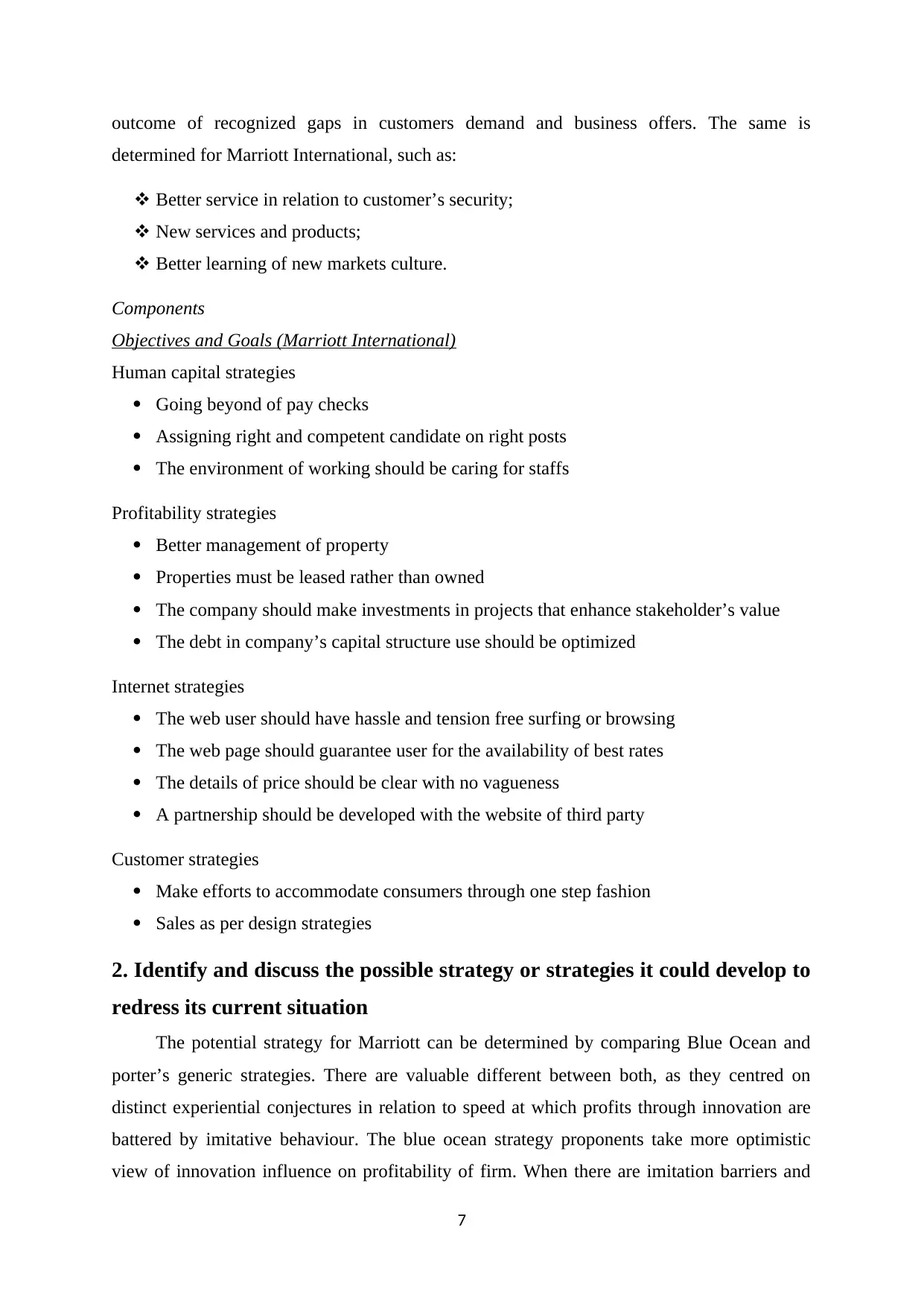
outcome of recognized gaps in customers demand and business offers. The same is
determined for Marriott International, such as:
Better service in relation to customer’s security;
New services and products;
Better learning of new markets culture.
Components
Objectives and Goals (Marriott International)
Human capital strategies
Going beyond of pay checks
Assigning right and competent candidate on right posts
The environment of working should be caring for staffs
Profitability strategies
Better management of property
Properties must be leased rather than owned
The company should make investments in projects that enhance stakeholder’s value
The debt in company’s capital structure use should be optimized
Internet strategies
The web user should have hassle and tension free surfing or browsing
The web page should guarantee user for the availability of best rates
The details of price should be clear with no vagueness
A partnership should be developed with the website of third party
Customer strategies
Make efforts to accommodate consumers through one step fashion
Sales as per design strategies
2. Identify and discuss the possible strategy or strategies it could develop to
redress its current situation
The potential strategy for Marriott can be determined by comparing Blue Ocean and
porter’s generic strategies. There are valuable different between both, as they centred on
distinct experiential conjectures in relation to speed at which profits through innovation are
battered by imitative behaviour. The blue ocean strategy proponents take more optimistic
view of innovation influence on profitability of firm. When there are imitation barriers and
7
determined for Marriott International, such as:
Better service in relation to customer’s security;
New services and products;
Better learning of new markets culture.
Components
Objectives and Goals (Marriott International)
Human capital strategies
Going beyond of pay checks
Assigning right and competent candidate on right posts
The environment of working should be caring for staffs
Profitability strategies
Better management of property
Properties must be leased rather than owned
The company should make investments in projects that enhance stakeholder’s value
The debt in company’s capital structure use should be optimized
Internet strategies
The web user should have hassle and tension free surfing or browsing
The web page should guarantee user for the availability of best rates
The details of price should be clear with no vagueness
A partnership should be developed with the website of third party
Customer strategies
Make efforts to accommodate consumers through one step fashion
Sales as per design strategies
2. Identify and discuss the possible strategy or strategies it could develop to
redress its current situation
The potential strategy for Marriott can be determined by comparing Blue Ocean and
porter’s generic strategies. There are valuable different between both, as they centred on
distinct experiential conjectures in relation to speed at which profits through innovation are
battered by imitative behaviour. The blue ocean strategy proponents take more optimistic
view of innovation influence on profitability of firm. When there are imitation barriers and
7
⊘ This is a preview!⊘
Do you want full access?
Subscribe today to unlock all pages.

Trusted by 1+ million students worldwide
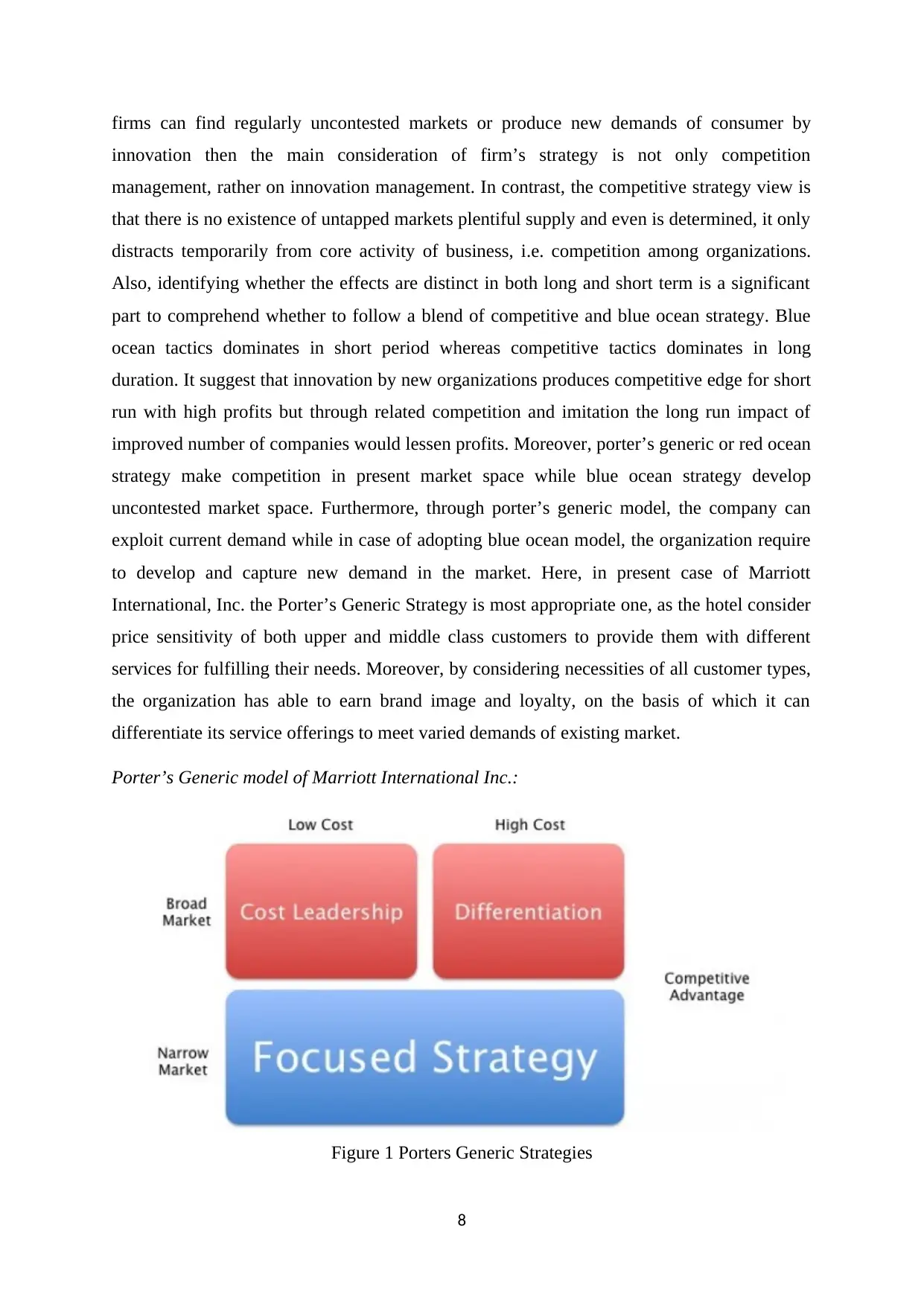
firms can find regularly uncontested markets or produce new demands of consumer by
innovation then the main consideration of firm’s strategy is not only competition
management, rather on innovation management. In contrast, the competitive strategy view is
that there is no existence of untapped markets plentiful supply and even is determined, it only
distracts temporarily from core activity of business, i.e. competition among organizations.
Also, identifying whether the effects are distinct in both long and short term is a significant
part to comprehend whether to follow a blend of competitive and blue ocean strategy. Blue
ocean tactics dominates in short period whereas competitive tactics dominates in long
duration. It suggest that innovation by new organizations produces competitive edge for short
run with high profits but through related competition and imitation the long run impact of
improved number of companies would lessen profits. Moreover, porter’s generic or red ocean
strategy make competition in present market space while blue ocean strategy develop
uncontested market space. Furthermore, through porter’s generic model, the company can
exploit current demand while in case of adopting blue ocean model, the organization require
to develop and capture new demand in the market. Here, in present case of Marriott
International, Inc. the Porter’s Generic Strategy is most appropriate one, as the hotel consider
price sensitivity of both upper and middle class customers to provide them with different
services for fulfilling their needs. Moreover, by considering necessities of all customer types,
the organization has able to earn brand image and loyalty, on the basis of which it can
differentiate its service offerings to meet varied demands of existing market.
Porter’s Generic model of Marriott International Inc.:
Figure 1 Porters Generic Strategies
8
innovation then the main consideration of firm’s strategy is not only competition
management, rather on innovation management. In contrast, the competitive strategy view is
that there is no existence of untapped markets plentiful supply and even is determined, it only
distracts temporarily from core activity of business, i.e. competition among organizations.
Also, identifying whether the effects are distinct in both long and short term is a significant
part to comprehend whether to follow a blend of competitive and blue ocean strategy. Blue
ocean tactics dominates in short period whereas competitive tactics dominates in long
duration. It suggest that innovation by new organizations produces competitive edge for short
run with high profits but through related competition and imitation the long run impact of
improved number of companies would lessen profits. Moreover, porter’s generic or red ocean
strategy make competition in present market space while blue ocean strategy develop
uncontested market space. Furthermore, through porter’s generic model, the company can
exploit current demand while in case of adopting blue ocean model, the organization require
to develop and capture new demand in the market. Here, in present case of Marriott
International, Inc. the Porter’s Generic Strategy is most appropriate one, as the hotel consider
price sensitivity of both upper and middle class customers to provide them with different
services for fulfilling their needs. Moreover, by considering necessities of all customer types,
the organization has able to earn brand image and loyalty, on the basis of which it can
differentiate its service offerings to meet varied demands of existing market.
Porter’s Generic model of Marriott International Inc.:
Figure 1 Porters Generic Strategies
8
Paraphrase This Document
Need a fresh take? Get an instant paraphrase of this document with our AI Paraphraser
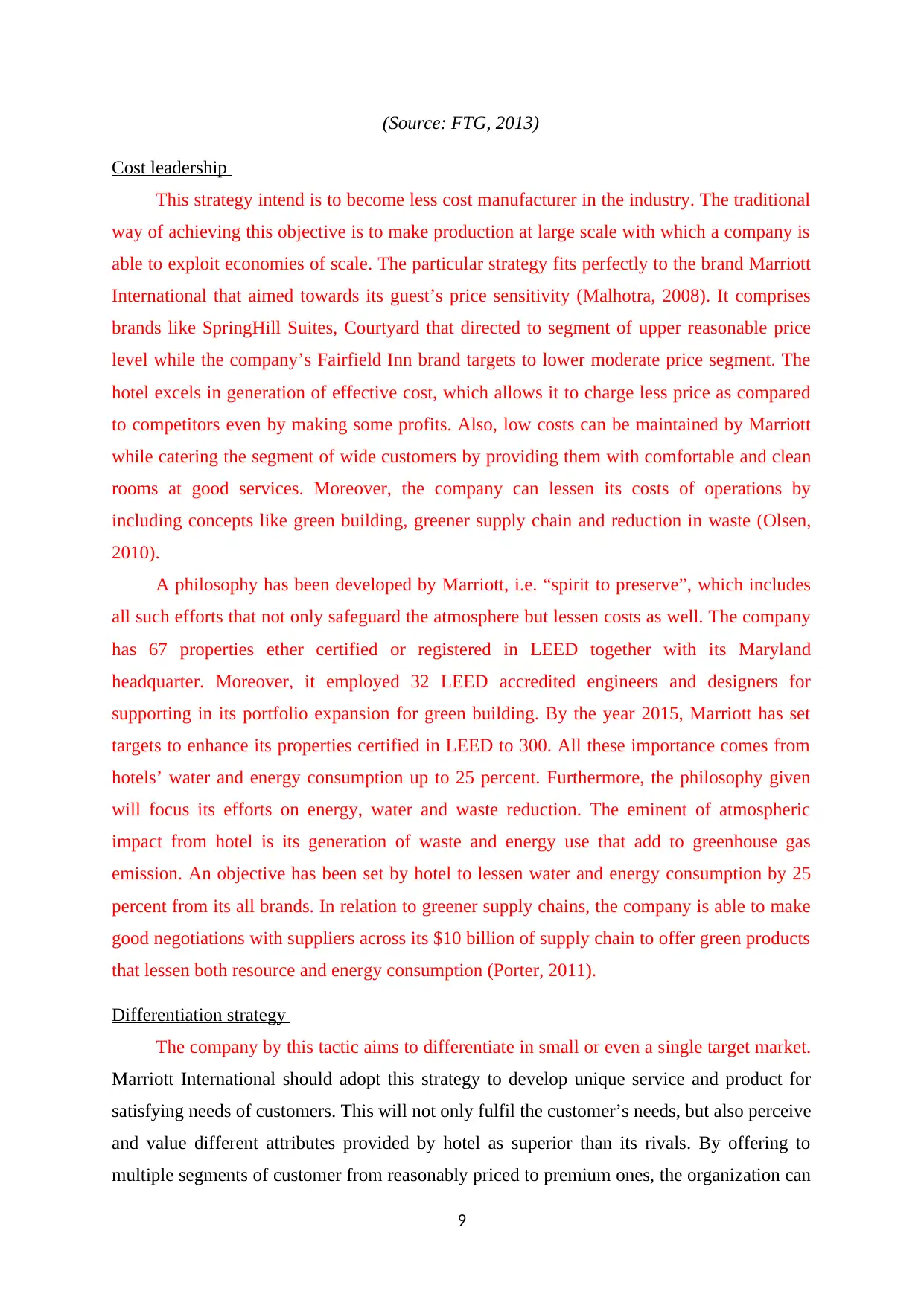
(Source: FTG, 2013)
Cost leadership
This strategy intend is to become less cost manufacturer in the industry. The traditional
way of achieving this objective is to make production at large scale with which a company is
able to exploit economies of scale. The particular strategy fits perfectly to the brand Marriott
International that aimed towards its guest’s price sensitivity (Malhotra, 2008). It comprises
brands like SpringHill Suites, Courtyard that directed to segment of upper reasonable price
level while the company’s Fairfield Inn brand targets to lower moderate price segment. The
hotel excels in generation of effective cost, which allows it to charge less price as compared
to competitors even by making some profits. Also, low costs can be maintained by Marriott
while catering the segment of wide customers by providing them with comfortable and clean
rooms at good services. Moreover, the company can lessen its costs of operations by
including concepts like green building, greener supply chain and reduction in waste (Olsen,
2010).
A philosophy has been developed by Marriott, i.e. “spirit to preserve”, which includes
all such efforts that not only safeguard the atmosphere but lessen costs as well. The company
has 67 properties ether certified or registered in LEED together with its Maryland
headquarter. Moreover, it employed 32 LEED accredited engineers and designers for
supporting in its portfolio expansion for green building. By the year 2015, Marriott has set
targets to enhance its properties certified in LEED to 300. All these importance comes from
hotels’ water and energy consumption up to 25 percent. Furthermore, the philosophy given
will focus its efforts on energy, water and waste reduction. The eminent of atmospheric
impact from hotel is its generation of waste and energy use that add to greenhouse gas
emission. An objective has been set by hotel to lessen water and energy consumption by 25
percent from its all brands. In relation to greener supply chains, the company is able to make
good negotiations with suppliers across its $10 billion of supply chain to offer green products
that lessen both resource and energy consumption (Porter, 2011).
Differentiation strategy
The company by this tactic aims to differentiate in small or even a single target market.
Marriott International should adopt this strategy to develop unique service and product for
satisfying needs of customers. This will not only fulfil the customer’s needs, but also perceive
and value different attributes provided by hotel as superior than its rivals. By offering to
multiple segments of customer from reasonably priced to premium ones, the organization can
9
Cost leadership
This strategy intend is to become less cost manufacturer in the industry. The traditional
way of achieving this objective is to make production at large scale with which a company is
able to exploit economies of scale. The particular strategy fits perfectly to the brand Marriott
International that aimed towards its guest’s price sensitivity (Malhotra, 2008). It comprises
brands like SpringHill Suites, Courtyard that directed to segment of upper reasonable price
level while the company’s Fairfield Inn brand targets to lower moderate price segment. The
hotel excels in generation of effective cost, which allows it to charge less price as compared
to competitors even by making some profits. Also, low costs can be maintained by Marriott
while catering the segment of wide customers by providing them with comfortable and clean
rooms at good services. Moreover, the company can lessen its costs of operations by
including concepts like green building, greener supply chain and reduction in waste (Olsen,
2010).
A philosophy has been developed by Marriott, i.e. “spirit to preserve”, which includes
all such efforts that not only safeguard the atmosphere but lessen costs as well. The company
has 67 properties ether certified or registered in LEED together with its Maryland
headquarter. Moreover, it employed 32 LEED accredited engineers and designers for
supporting in its portfolio expansion for green building. By the year 2015, Marriott has set
targets to enhance its properties certified in LEED to 300. All these importance comes from
hotels’ water and energy consumption up to 25 percent. Furthermore, the philosophy given
will focus its efforts on energy, water and waste reduction. The eminent of atmospheric
impact from hotel is its generation of waste and energy use that add to greenhouse gas
emission. An objective has been set by hotel to lessen water and energy consumption by 25
percent from its all brands. In relation to greener supply chains, the company is able to make
good negotiations with suppliers across its $10 billion of supply chain to offer green products
that lessen both resource and energy consumption (Porter, 2011).
Differentiation strategy
The company by this tactic aims to differentiate in small or even a single target market.
Marriott International should adopt this strategy to develop unique service and product for
satisfying needs of customers. This will not only fulfil the customer’s needs, but also perceive
and value different attributes provided by hotel as superior than its rivals. By offering to
multiple segments of customer from reasonably priced to premium ones, the organization can
9
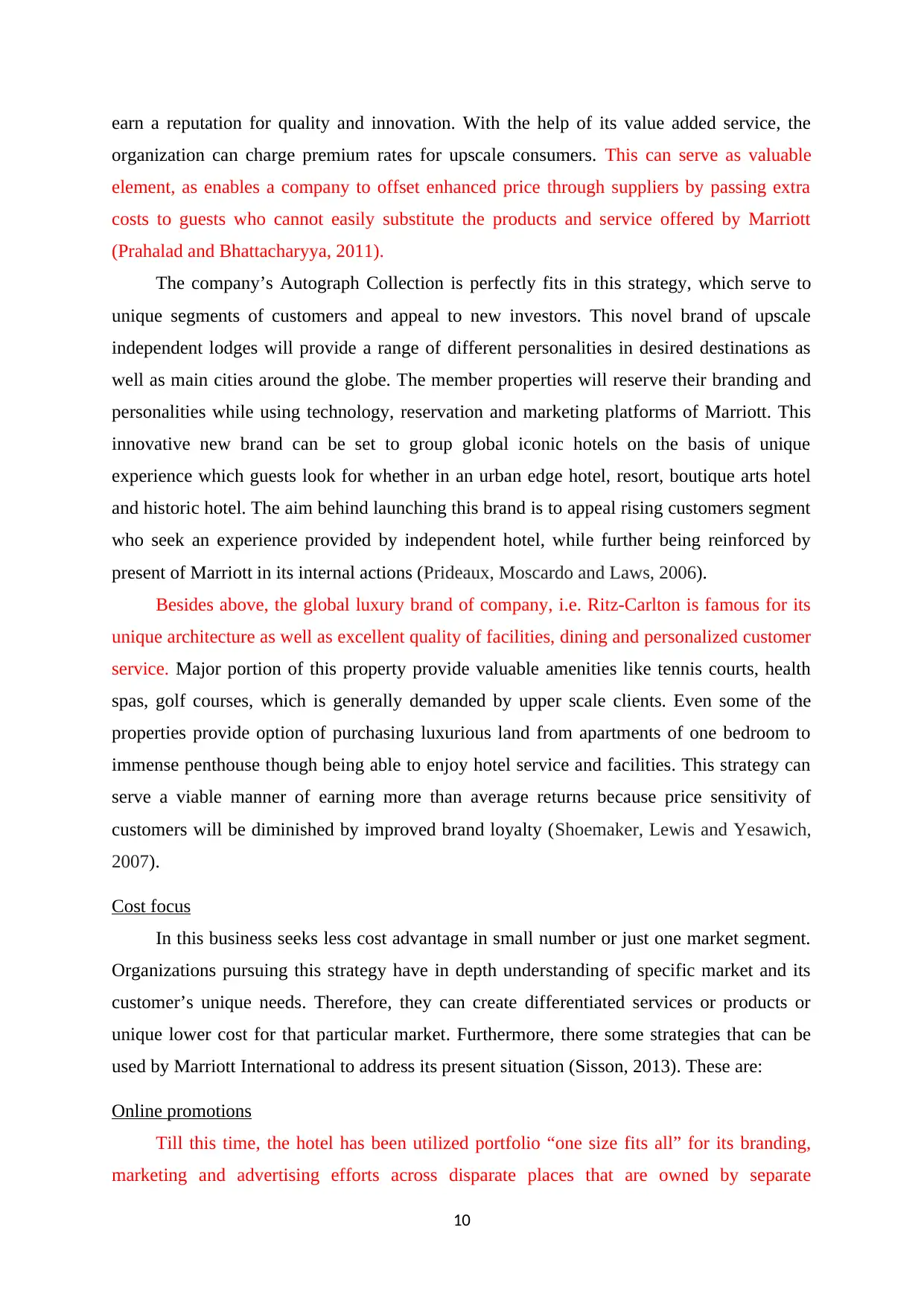
earn a reputation for quality and innovation. With the help of its value added service, the
organization can charge premium rates for upscale consumers. This can serve as valuable
element, as enables a company to offset enhanced price through suppliers by passing extra
costs to guests who cannot easily substitute the products and service offered by Marriott
(Prahalad and Bhattacharyya, 2011).
The company’s Autograph Collection is perfectly fits in this strategy, which serve to
unique segments of customers and appeal to new investors. This novel brand of upscale
independent lodges will provide a range of different personalities in desired destinations as
well as main cities around the globe. The member properties will reserve their branding and
personalities while using technology, reservation and marketing platforms of Marriott. This
innovative new brand can be set to group global iconic hotels on the basis of unique
experience which guests look for whether in an urban edge hotel, resort, boutique arts hotel
and historic hotel. The aim behind launching this brand is to appeal rising customers segment
who seek an experience provided by independent hotel, while further being reinforced by
present of Marriott in its internal actions (Prideaux, Moscardo and Laws, 2006).
Besides above, the global luxury brand of company, i.e. Ritz-Carlton is famous for its
unique architecture as well as excellent quality of facilities, dining and personalized customer
service. Major portion of this property provide valuable amenities like tennis courts, health
spas, golf courses, which is generally demanded by upper scale clients. Even some of the
properties provide option of purchasing luxurious land from apartments of one bedroom to
immense penthouse though being able to enjoy hotel service and facilities. This strategy can
serve a viable manner of earning more than average returns because price sensitivity of
customers will be diminished by improved brand loyalty (Shoemaker, Lewis and Yesawich,
2007).
Cost focus
In this business seeks less cost advantage in small number or just one market segment.
Organizations pursuing this strategy have in depth understanding of specific market and its
customer’s unique needs. Therefore, they can create differentiated services or products or
unique lower cost for that particular market. Furthermore, there some strategies that can be
used by Marriott International to address its present situation (Sisson, 2013). These are:
Online promotions
Till this time, the hotel has been utilized portfolio “one size fits all” for its branding,
marketing and advertising efforts across disparate places that are owned by separate
10
organization can charge premium rates for upscale consumers. This can serve as valuable
element, as enables a company to offset enhanced price through suppliers by passing extra
costs to guests who cannot easily substitute the products and service offered by Marriott
(Prahalad and Bhattacharyya, 2011).
The company’s Autograph Collection is perfectly fits in this strategy, which serve to
unique segments of customers and appeal to new investors. This novel brand of upscale
independent lodges will provide a range of different personalities in desired destinations as
well as main cities around the globe. The member properties will reserve their branding and
personalities while using technology, reservation and marketing platforms of Marriott. This
innovative new brand can be set to group global iconic hotels on the basis of unique
experience which guests look for whether in an urban edge hotel, resort, boutique arts hotel
and historic hotel. The aim behind launching this brand is to appeal rising customers segment
who seek an experience provided by independent hotel, while further being reinforced by
present of Marriott in its internal actions (Prideaux, Moscardo and Laws, 2006).
Besides above, the global luxury brand of company, i.e. Ritz-Carlton is famous for its
unique architecture as well as excellent quality of facilities, dining and personalized customer
service. Major portion of this property provide valuable amenities like tennis courts, health
spas, golf courses, which is generally demanded by upper scale clients. Even some of the
properties provide option of purchasing luxurious land from apartments of one bedroom to
immense penthouse though being able to enjoy hotel service and facilities. This strategy can
serve a viable manner of earning more than average returns because price sensitivity of
customers will be diminished by improved brand loyalty (Shoemaker, Lewis and Yesawich,
2007).
Cost focus
In this business seeks less cost advantage in small number or just one market segment.
Organizations pursuing this strategy have in depth understanding of specific market and its
customer’s unique needs. Therefore, they can create differentiated services or products or
unique lower cost for that particular market. Furthermore, there some strategies that can be
used by Marriott International to address its present situation (Sisson, 2013). These are:
Online promotions
Till this time, the hotel has been utilized portfolio “one size fits all” for its branding,
marketing and advertising efforts across disparate places that are owned by separate
10
⊘ This is a preview!⊘
Do you want full access?
Subscribe today to unlock all pages.

Trusted by 1+ million students worldwide
1 out of 23
Related Documents
Your All-in-One AI-Powered Toolkit for Academic Success.
+13062052269
info@desklib.com
Available 24*7 on WhatsApp / Email
![[object Object]](/_next/static/media/star-bottom.7253800d.svg)
Unlock your academic potential
Copyright © 2020–2025 A2Z Services. All Rights Reserved. Developed and managed by ZUCOL.



